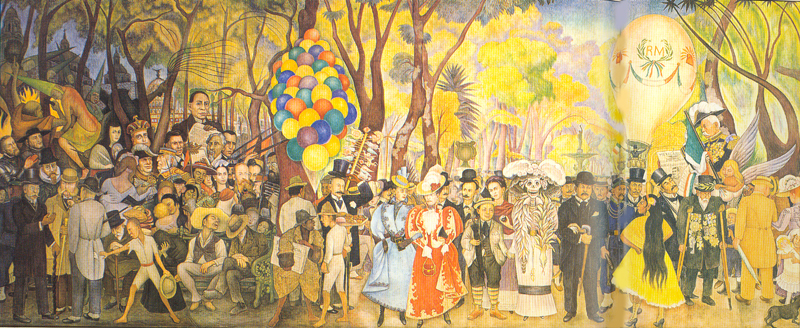Source: WTL research files. For WTL photos© of the museum in which this mural is housed and his detailed photos of the mural on site, where this museum and the mural are placed in the textbook's context of Mexico City, see: => Mexico City #12.
Mural: Left 2/3 of "Dream of a Sunday Afternoon in the Alameda" (1947) for the Hotel del Prado, on the Avenida Juárez, which is right across the street from the Alameda and the Palacio de Bellas Artes in Mexico City. For the right 1/3 of this mural, see: => Diego Rivera #34a.
Biographical data: From 1945 to 1947, he paints "The Great City of Tenochtitlán" in the Palacio Nacional, and he paints the giant masterpiece you see above.
Comments:"Alameda Park" was painted after the height of Mexican muralism. By the 1940's modern artists like Jackson Pollock, who had studied with Rivera, had moved on to abstract expressionism. This mural is monumentally large; it measures roughtly 15 feet high by 50 feet long, and it is an appropriate huge panorama of Mexican history seen in a festive light. Diego Rivera paints himself as a boy just to our left of the skeleton figure (la calavera: see below) bottom center-right. Just behind him is Frida Kahlo. José Martí is just behind him over his right shoulder. Porfirio Díaz is the military figure on the far right. On the extreme left is a scene of the Spanish colonial Inquisition, where heretics were burned at the stake (this place in the park was the original site of such executions). The large head to the left of the balloons is Benito Juárez, the hero of Mexican independence from the French in the middle of the 19th century. Many more of the figures can be recognized ,including, for example, Sor Juana Inés de la Cruz just to the right of the Inquisition scene at the left of the mural. In 1592, the viceroy of New Spain, Luis de Velasco, converted the space occupied by the park, which was once an Aztec market place, into a
public park. In La Alameda Park is the grand monument (also called the Hemiciclo or hemicycle) dedicated to Benito Juárez, directly facing Avenida Juárez.
Humanities theme: Evaluate this mural as a summation of the works of Diego Rivera.
Internet link. For a fine
video and Mexican song showing the full panorama of this mural, see the following website: => El ángel caído.
The skeleton: This female skeletal figure is known throughout Mexico as la Catrina (the "lady dandy"; notice the similarity to the name of the horrific hurricane, Katrina, that struck New Orleans in 2005). The origin of this figure of Death is an etching by José Guadalupe Posada, la Calavera Catrina (1913); see: => La calavera Catrina. The figure became so famous in all Mexican social classes that it is synonymous with the art of Mexico itself.
Humanites question on la Catrina: How do you interpret both Posada's etching and Rivera's full figure of la Catrina?


